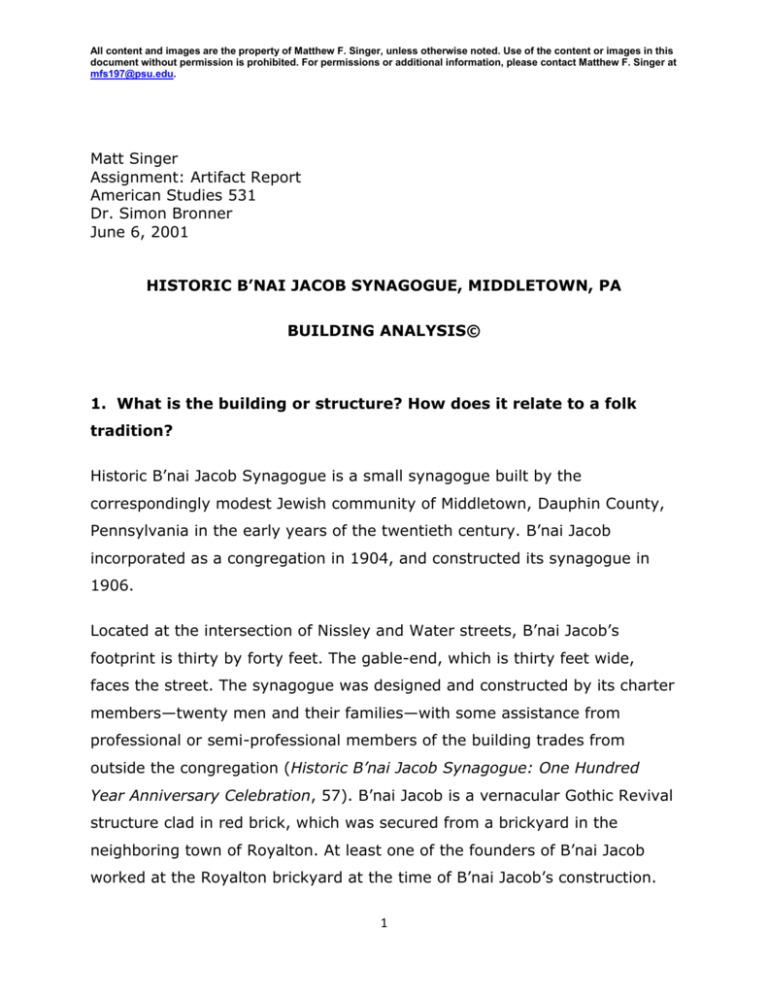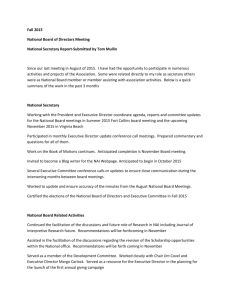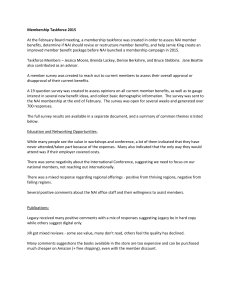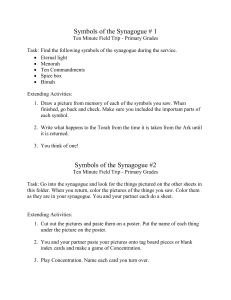b`nai jacob building analysis - Historic B`nai Jacob Synagogue
advertisement

All content and images are the property of Matthew F. Singer, unless otherwise noted. Use of the content or images in this document without permission is prohibited. For permissions or additional information, please contact Matthew F. Singer at mfs197@psu.edu. Matt Singer Assignment: Artifact Report American Studies 531 Dr. Simon Bronner June 6, 2001 HISTORIC B’NAI JACOB SYNAGOGUE, MIDDLETOWN, PA BUILDING ANALYSIS© 1. What is the building or structure? How does it relate to a folk tradition? Historic B’nai Jacob Synagogue is a small synagogue built by the correspondingly modest Jewish community of Middletown, Dauphin County, Pennsylvania in the early years of the twentieth century. B’nai Jacob incorporated as a congregation in 1904, and constructed its synagogue in 1906. Located at the intersection of Nissley and Water streets, B’nai Jacob’s footprint is thirty by forty feet. The gable-end, which is thirty feet wide, faces the street. The synagogue was designed and constructed by its charter members—twenty men and their families—with some assistance from professional or semi-professional members of the building trades from outside the congregation (Historic B’nai Jacob Synagogue: One Hundred Year Anniversary Celebration, 57). B’nai Jacob is a vernacular Gothic Revival structure clad in red brick, which was secured from a brickyard in the neighboring town of Royalton. At least one of the founders of B’nai Jacob worked at the Royalton brickyard at the time of B’nai Jacob’s construction. 1 All content and images are the property of Matthew F. Singer, unless otherwise noted. Use of the content or images in this document without permission is prohibited. For permissions or additional information, please contact Matthew F. Singer at mfs197@psu.edu. At a most basic level, B’nai Jacob is “folk” because it was built by a cohesive group—in this case, an ethnoreligious community—according to a traditional compositional plan, using local material. The synagogue is, in addition, a material manifestation of at least two folk traditions. Its founders were, overwhelmingly, Lithuanian Jewish immigrants. Oral lore notes that the founders were not only all, or nearly all, Lithuanian, but were from small, rural villages in the vicinity of the city of Panevezys in north-central Lithuania. Records available through JewishGen, a Jewish genealogy website, confirm this assertion. An addendum to the synagogue’s National Register of Historic Places Inventory—Nomination Form (B’nai Jacob was granted historic status in 1985), states that B’nai Jacob’s members were, primarily, from the village of Pusalotas in north-central Lithuania. These Lithuanian Jews were adventurous enough to immigrate to the United States and settle in an obscure, rural town (in these characteristics, of course, Middletown was similar to the villages from which B’nai Jacob’s founders hailed) with a minuscule Jewish community and no Jewish institutions prior to the building of the synagogue. Nonetheless, they maintained traditional Eastern European Orthodox practice, which included living within walking distance of a synagogue, as traditional Jewish law forbids traveling by vehicle on the Sabbath. Moreover, for the members of B’nai Jacob, the synagogue filled the three roles of a traditional, Eastern European shul (shul is the informal Yiddish term for synagogue, deriving from the German schule, which corresponds to the English “school”). B’nai Jacob was a beit tefilah (house of prayer), beit midrash (house of study), and beit knesset (house of meeting). Its members gathered within its walls to worship, sent their children to the shul for their Jewish education, and conducted their official and social communal at B’nai Jacob. 2 All content and images are the property of Matthew F. Singer, unless otherwise noted. Use of the content or images in this document without permission is prohibited. For permissions or additional information, please contact Matthew F. Singer at mfs197@psu.edu. The second, far broader folk tradition represented by B’nai Jacob is the adoption of the Gothic Revival style by members of diverse, immigrant religious groups once they settled into communities—typically towns at some remove from the major cities along the eastern seaboard—and gained the means to build houses of worship. Gothic Revival served as architectural shorthand for “American religious structure,” even—despite very strong Christian associations—for Jews (Chiat, 14). Small, vernacular Gothic Revival synagogues remarkably similar to B’nai Jacob are still found in Ocala, Florida (www.wikipedia.org); Brenham, Texas (www.smallsynagogues.com; see figure 8); Brownsville, Tennessee; Burlington, Vermont; Stevens Point, Wisconsin (Chiat, 14, 36, 296); and Edenbridge, Saskatchewan, Canada (www.wikipedia.com), among other locales. In most of the aforementioned locations—as is the case with B’nai Jacob—the anonymous “American” exterior sheltered a distinctly Eastern European Orthodox interior. Characteristic of the Eastern European shul are a bimah (a raised platform from which the Torah is read) placed in the center of the sanctuary; the aron ha’kodesh (“Holy Ark,” in which the Torah scroll is stored) at the center of the eastern wall, pointing the congregation in the direction of Jerusalem; and separate seating areas for women and men. 2. What was the original use of the building or structure? B’nai Jacob was built as a synagogue and maintains that function to this day. It began as an Orthodox congregation, but has shifted in recent decades to Conservative Jewish practice, although it is not officially affiliated with the Conservative Jewish movement. 3 All content and images are the property of Matthew F. Singer, unless otherwise noted. Use of the content or images in this document without permission is prohibited. For permissions or additional information, please contact Matthew F. Singer at mfs197@psu.edu. 3. When was it built? What additions or changes were made to it over time? The synagogue was built in 1906. An imposing stoop structure, with two stairways running parallel to the building, was added in 1921. A relatively small, metal Star of David was placed atop the synagogue’s street-facing gable-end at a later date. Carpeting has been placed in the aisle between the pews and in other areas of the sanctuary. Otherwise, B’nai Jacob remains as it was originally built. 4. What materials were used in the building or structure? B’nai Jacob’s exterior is brick with an asphalt-shingled roof. Its pointed Gothic Revival windows contain polychromatic leaded-glass panels. An oculus window, divided into eight lights, rests below the gable on the building’s front facade. B’nai Jacob’s interior walls are plaster with wood, bead-board wainscoting. All of its furnishings, both loose and built-in, are wood. Among these furnishings and features are Classical Revival pillars that demarcate the temple-like entablature around the Holy Ark and support the cornice, upon which rest a carved sculptural group composed of the twin tablets of the Decalogue flanked by rampant lions—a traditional motif in Eastern European synagogues. B’nai Jacob’s wood pews were salvaged from a previous iteration of the Dauphin County courthouse in nearby Harrisburg. 5. Describe its overall condition? What are its surroundings? 4 All content and images are the property of Matthew F. Singer, unless otherwise noted. Use of the content or images in this document without permission is prohibited. For permissions or additional information, please contact Matthew F. Singer at mfs197@psu.edu. B’nai Jacob is an exceptionally well-built and well-maintained structure. As B’nai Jacob does not charge dues, its excellent condition is a credit to the generosity and diligence of its members and others, including the children of former (now deceased) members. The proximity of the Pennsylvania State University’s Harrisburg campus (which is in Middletown) and its American Studies faculty and students—who often have a particular orientation to the study and documentation of folk material-culture—and the sizable and active Jewish community of Harrisburg have certainly benefited B’nai Jacob and may help to explain its continued existence as an operating synagogue. 6. Are there any unique features? Explain. As mentioned earlier, B’nai Jacob’s Gothic Revival style—an architectural mode that is strongly associated with Christanity—would seem an anomalous choice for a synagogue. Yet B’nai Jacob, and other small-town synagogues, were built in vernacular version of Gothic Revival so as to blend in with other houses of worship in overwhelmingly non-Jewish communities. These smalltown synagogues—typically built in the decades before and after the turn of the twentieth century, which were marked by the arrival of some 2.5 million Eastern European Jews accustomed to Orthodox practice—were anonymously “American” on the exterior but traditional Orthodox in their interior arrangements. Those who built B’nai Jacob seem to have been particularly reticent about proclaiming its Jewishness to the outside world. The only Jewish signifier that has been part of the building since its dedication is the cornerstone, which bears the name of the synagogue and the year of its completion according to the Jewish calendar (see figure 7 on page 17). The small Star of David atop the synagogue’s gable was, as noted before, a later addition. 5 All content and images are the property of Matthew F. Singer, unless otherwise noted. Use of the content or images in this document without permission is prohibited. For permissions or additional information, please contact Matthew F. Singer at mfs197@psu.edu. Unlike much American vernacular Gothic Revival architecture, which was clad in clapboard—thus, “Carpenter Gothic”—B’nai Jacob is a brick structure. This reflects the availability of brick trough the Royalton brickyards and the predilection for red brick among the residents of Pennsylvania towns (Zelinsky, 133). The use of brick—which lends an air of substance and permanence—is particularly refined at B’nai Jacob. This is seen in the corbelled capital of the corner pilaster, the corbelled eave, and the coffer panels that frame the windows and doorway. Another graceful, unexpected detail marking B’nai Jacob is its ceiling, the corners of which curve rather than meet in right angles. One could argue that the synagogue’s founders took seriously the Jewish imperative of hiddur mitzvah—to beautify the commandment—and that these details are elegant manifestations of this value. Seemingly distinctive to B’nai Jacob is the composition of its Holy Ark. In most synagogues, the Holy Ark is a cabinet that projects from the wall. At B’nai Jacob, the section of the Holy Ark that holds the Torah scrolls is recessed into the wall (resulting in a corresponding projection on the building’s rear façade). The raised platform, columns, cornice, and sculptural decoration (the Decalogue and rampant lions) give B’nai Jacob’s unusual Holy Ark the appearance of a more typical example of the form. It is likely that this unique composition was a means to save precious space in the small sanctuary. 7. What does it say about life when it was built? What are the ascribed uses of the rooms? 6 All content and images are the property of Matthew F. Singer, unless otherwise noted. Use of the content or images in this document without permission is prohibited. For permissions or additional information, please contact Matthew F. Singer at mfs197@psu.edu. B’nai Jacob speaks to immigrant founders’ paired goals—to blend into American society while maintaining their Jewish identity. While conservative, Central Pennsylvania is not known historically for overt anti-Semitism. We do not know whether B’nai Jacob’s lack of exterior Jewish signifiers was intended to preclude anti-Semitic acts that were perceived by the synagogue’s members as likely to occur in Middletown, or whether the synagogue’s ambiguous exterior reflected fears brought by the members from Russia’s violently anti-Semitic Pale of Settlement to Middletown. B’nai Jacob’s primary room is its sanctuary. A foyer inside the entrance leads to the sanctuary; a small room containing prayer-books and prayer shawls; a stairway that leads to a downstairs recreation and multiple-use room; and a handsome stairway leading to the balcony. 8. Provide a sketch of the floor plan and elevation, and photograph of the structure. Two floor plans can be found on pages 21 and 22, and an elevation on page 23. Photographs are found on pages 12 to 18. 9. Describe your "field trip." My field trip took place on the afternoon of Wednesday, June 1. It was coordinated through Lawrence Kapenstein, the congregation’s treasurer and shamas, the synagogue official who manages day-to-day affairs. Unfortunately, I had only an hour and three-quarters to survey and photograph the interior and exterior of the synagogue on that day. I am a 7 All content and images are the property of Matthew F. Singer, unless otherwise noted. Use of the content or images in this document without permission is prohibited. For permissions or additional information, please contact Matthew F. Singer at mfs197@psu.edu. direct descendant of B’nai Jacob founder David Singer (1867–1929) and a collateral descendant of my great-grandfather’s fellow founder Philip Singer and his son Abraham, who served for many years as the synagogue’s president and in other leadership positions. With that said, and although I grew up within a twenty-minute drive from B’nai Jacob, I was unaware of it or my family’s connection to it until I was in my twenties. I have, in succeeding years, visited the synagogue on several occasions and once attended a Rosh Hashanah service at B’nai Jacob. 10. Categorize it into types and subtypes. Do the users have a name for it that differs from your categorization? B’nai Jacob is an Ashkenazic Jewish synagogue (Ashkenazim are the Yiddish and German speaking Jews of Central and Eastern European descent; Ashkenaz is the Hebrew word for “Germany”). Most specifically, within the sphere of synagogues built by Eastern European immigrants to the United States during and as a result of the massive migration that took place between 1880 and 1920, it is a small-town synagogue situated in what was a rural setting. While it was common for German Jews, who came to the United States a generation or more before the Eastern Europeans, to move inland and work in a trajectory that took them from peddlers to shopkeepers and beyond, this track was somewhat anomalous among Eastern European Jewish immigrants (see Deborah R. Weiner’s Coalfield Jews: An Appalachian History). Of those Eastern Europeans who established lives away from the major eastern port cities, the majority were Lithuanian or Hungarian Jews who arrived before 1900. B’nai Jacob and the history of Middletown’s Jewish community reflect this immigration pattern. 8 All content and images are the property of Matthew F. Singer, unless otherwise noted. Use of the content or images in this document without permission is prohibited. For permissions or additional information, please contact Matthew F. Singer at mfs197@psu.edu. 11. How did visiting the building or structure add to your understanding of the form? Already an admirer of B’nai Jacob’s restrained, modest beauty, this visit greatly heightened my awareness of the quality of the synagogue’s construction and how well it has been maintained. That this has been achieved through an all-volunteer effort—the synagogue has no paid staff, and its worship services are lay-led—over the course of many decades makes this achievement all the more remarkable. 12. What are sources—library and human—for its study (include works that have artifacts that are comparable)? A preliminary bibliography can be found on pages 10 and 11. Human resources include Stanley Singer and Judith Zernik Singer, of Camp Hill and Philadelphia, respectively, who are the children—now in their golden years, of course—of Abraham Singer, the grandchildren of B’nai Jacob founder Philip Singer, and were raised in Middletown attending the synagogue. In addition, a trove of unarchived, historic papers have been retrieved from the home of a recently deceased gentleman who served as the synagogue’s shamas for decades. 9 All content and images are the property of Matthew F. Singer, unless otherwise noted. Use of the content or images in this document without permission is prohibited. For permissions or additional information, please contact Matthew F. Singer at mfs197@psu.edu. BIBLIOGRAPHY Chiat, Marilyn J. America’s Religious Architecture: Sacred Places for Every Community. New York: John Wiley & Sons, Inc, 1997. Gruber, Samuel D. American Synagogues: A Century of Architecture and Jewish Community. New York: Rizzoli, 2003. Historic B’nai Jacob Synagogue: One Hundred Year Anniversary Celebration. Middletown, PA: B’nai Jacob Synagogue, 2004. Katz, Dovid. Lithuanian Jewish Culture. Vilnius, Lithuania: Vilnius University, 2004 (Lithuanian edition)/2010 (English edition). Krinsky, Carol Herselle. Synagogues of Europe: Architecture, History, Meaning. Mineola, NY: Dover Publications, Inc., 1985, MIT Press/1996. United States Department of the Interior, National Park Service, National Register of Historic Places Inventory. Weiner, Deborah R. Coalfield Jews: An Appalachian History. Champaign, IL: University of Illinois Press, 2006. Weissbach, Lee Shai. Jewish Life in Small-Town America: A History. New Haven, CT: Yale University Press, 2005. www.jewishgen.org www.pusalotas.org www.smalsynagogues.com 10 All content and images are the property of Matthew F. Singer, unless otherwise noted. Use of the content or images in this document without permission is prohibited. For permissions or additional information, please contact Matthew F. Singer at mfs197@psu.edu. Zelinsky, Wilbur. “The Pennsylvania Town: An Overdue Geographical Account.” Geographical Review, Vol. 67, No. 2 (April 1977), pp. 127–147. Zimiles, Murray. Gilded Lions and Jeweled Horses: The Synagogue to the Carousel, Jewish Carving Traditions. Waltham, MA: Brandeis University Press in association with the American Folk Art Museum, New York, 2007. © for entire document (except photographs credited to B’nai Jacob): Matthew F. Singer 11 All content and images are the property of Matthew F. Singer, unless otherwise noted. Use of the content or images in this document without permission is prohibited. For permissions or additional information, please contact Matthew F. Singer at mfs197@psu.edu. Figure 1: Exterior view of Historic B’nai Jacob Synagogue, Middletown, Pennsylvania. Photo: B’nai Jacob 12 All content and images are the property of Matthew F. Singer, unless otherwise noted. Use of the content or images in this document without permission is prohibited. For permissions or additional information, please contact Matthew F. Singer at mfs197@psu.edu. Figure 2: Interior view of the sanctuary—including bimah and Holy Ark—as seen from the balcony. Photo: B’nai Jacob 13 All content and images are the property of Matthew F. Singer, unless otherwise noted. Use of the content or images in this document without permission is prohibited. For permissions or additional information, please contact Matthew F. Singer at mfs197@psu.edu. Figure 3: Detail of Holy Ark showing entablature, the curtain behind which the congregation’s Torah scrolls are stored, and the traditional, carved composition of the Decalogue and flanking, rampant lions atop the cornice. Photo: Matthew F. Singer 14 All content and images are the property of Matthew F. Singer, unless otherwise noted. Use of the content or images in this document without permission is prohibited. For permissions or additional information, please contact Matthew F. Singer at mfs197@psu.edu. Figure 4: Detail with bimah and reader’s desk in foreground. Photo: B’nai Jacob 15 All content and images are the property of Matthew F. Singer, unless otherwise noted. Use of the content or images in this document without permission is prohibited. For permissions or additional information, please contact Matthew F. Singer at mfs197@psu.edu. Figure 5: The balcony, which was originally used as the women’s gallery when the congregation followed Orthodox practices. Photo: Matthew F. Singer 16 All content and images are the property of Matthew F. Singer, unless otherwise noted. Use of the content or images in this document without permission is prohibited. For permissions or additional information, please contact Matthew F. Singer at mfs197@psu.edu. Figure 6: Original lighting fixture and balcony, as seen from the bimah. Photo: Matthew F. Singer 17 All content and images are the property of Matthew F. Singer, unless otherwise noted. Use of the content or images in this document without permission is prohibited. For permissions or additional information, please contact Matthew F. Singer at mfs197@psu.edu. Figure 7: Cornerstone. When B’nai Jacob was built, the cornerstone was the only exterior element that indicated the building was a Jewish house of prayer. Photo: Matthew F. Singer 18 All content and images are the property of Matthew F. Singer, unless otherwise noted. Use of the content or images in this document without permission is prohibited. For permissions or additional information, please contact Matthew F. Singer at mfs197@psu.edu. Figure 8: B’nai Abraham Synagogue, Brenham, Texas. Built in 1893, B’nai Abraham shares B’nai Jacob’s vernacular Gothic Revival style—complete with pointed arches above its windows and entrance—as well as an oculus window beneath the gable. More modest than B’nai Jacob, B’nai Abraham is clad in clapboard and features a far less elaborate stoop. 19 All content and images are the property of Matthew F. Singer, unless otherwise noted. Use of the content or images in this document without permission is prohibited. For permissions or additional information, please contact Matthew F. Singer at mfs197@psu.edu. Figure 9: Wood synagogue from the town of Zydikiai in north-central Lithuania, the region from which the majority of B’nai Jacob’s members immigrated. The town of Pusalotas had a wood synagogue that was destroyed by fire in 1913. The members of B’nai Jacob sent funds to the Jewish community of Pusalotas for the building of a brick synagogue. 20 All content and images are the property of Matthew F. Singer, unless otherwise noted. Use of the content or images in this document without permission is prohibited. For permissions or additional information, please contact Matthew F. Singer at mfs197@psu.edu. 21 All content and images are the property of Matthew F. Singer, unless otherwise noted. Use of the content or images in this document without permission is prohibited. For permissions or additional information, please contact Matthew F. Singer at mfs197@psu.edu. 22 All content and images are the property of Matthew F. Singer, unless otherwise noted. Use of the content or images in this document without permission is prohibited. For permissions or additional information, please contact Matthew F. Singer at mfs197@psu.edu. 23 All content and images are the property of Matthew F. Singer, unless otherwise noted. Use of the content or images in this document without permission is prohibited. For permissions or additional information, please contact Matthew F. Singer at mfs197@psu.edu. 24





